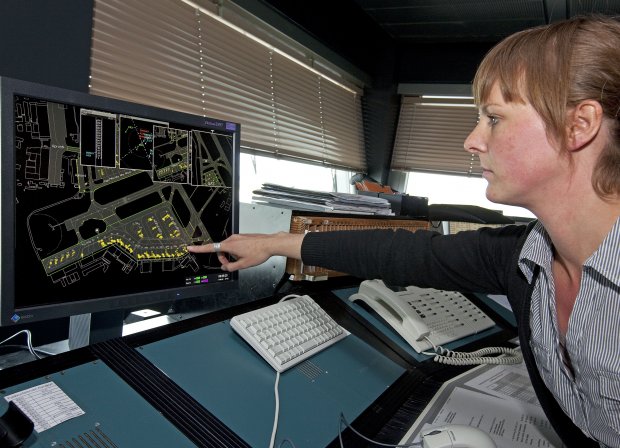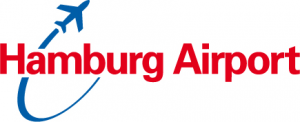Successful joint project for DFS, DLR and Hamburg Airport

A-SMGCS enters operation in Hamburg, facilitating improved traffic control on the apron
The ground situation monitoring system of the future has a name: A-SMGCS. And at Hamburg Airport, the future has already begun. The innovative "Advanced Surface Movement Guidance and Control System" has successfully entered operation at Hamburg Airport. The three project partners, DFS Deutsche Flugsicherung GmbH (German Air Traffic Services), DLR Deutsches Zentrum für Luft- und Raumfahrt e.V. (German Aerospace Center) and FHG Flughafen Hamburg GmbH (Hamburg Airport) presented their joint project, unique in Europe, at a press conference at Hamburg Airport.
Michael Eggenschwiler, CEO of Hamburg Airport: "We are really delighted that our cooperation with German Air Traffic Services and the German Aerospace Center, which began in 2008, is bearing fruit today. Hamburg Airport is one of the first airports in Europe where the visionary A-SMGCS ground radar is in operation. The simultaneous installation of a test environment linked with operative systems is unique in Europe. ASMGCS supports the work of apron controllers with optimised visual representation of the situation, contributes to increased security in ground traffic control and facilitates more efficient traffic management. This not only saves costs, it also benefits the environment. A-SMGCS will enable us to reduce airside emissions by a total of 10 percent."
The head of DFS, Dieter Kaden, praised both the new system itself and the strong, close cooperation between the airport, research & development, and air traffic control. "Only by working together can we master the challenge of making sure that air travel remains not only the safest but also the most punctual means of transport, even with future increases in traffic volume."
Prof. Dr Joachim Szodruch, the DLR board member responsible for aviation research, emphasised that "this new ground traffic management system and the associated test environment mean that we have created something that is to date unique in Europe: the possibility of optimising ground traffic movements, to organise processes in a safer way, and to decisively reduce the burden of apron controllers. This exemplary test environment is currently being utilised within the framework of the "Efficient Airport 2030" flagship project, thereby having a definitive influence on further research work within the field of Total Airport Management."
How A-SMGCS works
Every aircraft is fitted with a transponder, which transmits individual data to a total of 23 antennas located on the airport site. A-SMGCS uses this information to determine both the identity and the exact location of the aircraft. With the assistance of the current timetable, the relevant flight number is also determined. This information, combined with the precise representation of the aprons and runways, is shown on controllers' screens. Aircraft can be identified and located with precision. The routes taken by aircraft to and from the runways can also be optimised using A-SMGCS. The precision and reliability of the system make traffic management safer. A further benefit: when surface traffic is optimally managed, minimising aircraft turnaround times, then both fuel consumption and noise emissions are reduced. Implementing A-SMGCS meant laying 16km of cabling, fitting 23 antennas and installing a new surface radar system. Universities and the aviation industry are also involved in the project alongside the three partners, Hamburg Airport, DLR and DFS. This ensures that the ground traffic control system of the future is built on competence and efficiency in both research and practical implementation. The purchase costs of A-SMGCS are around five million euros and the operational costs are around 1 million euros per year.
A further step: CARMA
A-SMGCS forms the basis for a further research project: CARMA, which stands for "Car Management on Aprons". A concept and prototype have been developed to integrate apron vehicles, such as buses, baggage tugs and fuel trucks in the optimised representation of ground traffic, thus improving the operational processes of these vehicles. As part of a comprehensive field test, 15 apron vehicles have been fitted with GPS equipment. The position of the vehicles, determined using GPS, is then transmitted and received using WLAN. The current traffic situation is displayed on-screen for drivers and controllers. The movement of both aircraft and apron vehicles can thus be followed live on-screen. This, combined with a management system, enables the airport to further optimise processes and make them even safer. Project participants, alongside Hamburg Airport, are: AIRSYS, Airbus, German Air Traffic Services, the German Aerospace Center, Hamburg University of Technology, the University of Hamburg and the Carolo-
Wilhelmina Technical University of Braunschweig.
Hamburg - A Strong Aviation Location
This test environment places Hamburg at the cutting edge in Europe. The close cooperation between research, teaching, operations and industry at Hamburg Airport creates an environment that promotes accelerated innovation processes and contributes to Hamburg's leading position as a center of aviation. The cooperation between the airport, DFS and DLR also impressively underlines the effectiveness and performance of the Aviation Cluster Hamburg Metropolitan Region as a genuine leading edge cluster. Following on from the establishment of the Institute of Air Transport Concepts and Technology Valuation at the Hamburg University of Technology in 2007, this new project sees DLR further expanding its activities in Hamburg.


